
Preparing for the Unthinkable:
How COTS Modernized Triage Systems for Mass Casualty Events in Ohio
While no one wishes to contemplate a mass casualty event occurring locally, it offers reassurance to acknowledge an organization diligently preparing for such events behind the scenes. Columbus Medical Association Affiliate, COTS, has been doing the work to ensure we are all safe at events such as Ohio State University Football games, the Ohio State Fair, and summer concerts. Back in 2019, the organization took on a new task: modifying the triage system based on the current era of mass violence and the after-action reports of several mass shootings in the U.S. and abroad.
The push to modernize the system came after the U.S. Department of Health and Human Services released its Mass Casualty Trauma Triage Paradigms and Pitfalls document. The findings were released after COTS reached out to the government agency to ensure emergency response teams across the nation were prepared for any mass casualty event. COTS’ plan to reassess the triage system was quickly halted after the Covid-19 pandemic came to a head. This caused the organization to pivot to a new task: keeping Ohioans safe from the novel coronavirus.
Once the pandemic came to a plateau, COTS could get back to work on improving the triage system by convening multi-disciplinary workgroups in 37 of Ohio’s 88 counties they serve. COTS along with several healthcare leaders, like The Ohio State University Wexner Medical Center’s Dr. Nicholas Kman, sat down to discuss the use of the SALT method, also known as:
Sort
Assess
Life-Threatening Injuries
Treat/Transport
The conversation about the implementation of SALT took just over 4 months. A consensus from hospital trauma and emergency services, and first responders was obtained and the decision to recommend migration to SALT for 37 Ohio counties was made November 2022. The new system is endorsed by several prestigious organizations like the American Academy of Pediatrics, American Trauma Society, and so many more.
In January 2023, the SALT triage method was officially adopted into COTS’ system. The implementation included several educational opportunities like practicing during the Spring 2023 Mass Cass Incident training and a virtual reality session at the The Ohio State University College of Medicine. Shortly after, COTS used federal funding to purchase and distribute triage tag fanny packs to hospital and first responder healthcare coalition partners.
In some of the photos included you will notice 5 distinct color ribbons: Red, Blue, Green, Yellow, and Black. They all correlate to distinct phases of the triage system:
Red | Immediate
Severe injuries, Likely to survive given current resources
Blue | Expectant
Unlikely to survive given the current resources
Green | Minimal
The patient has only minor injuries
Yellow | Delayed
Serious medical problems, but expected to survive
Black
Deceased
Several COTS leaders say the SALT system is more efficient than the previous one, START, which would have slowed triage, and even excluded some of the categories listed above. Much of COTS’ organizing for mass casualty events happens behind the scenes, but it is their proactive work that improves the health and safety of the communities they serve.
Good Health by the Numbers
COTS partners are organized and coordinated throughout 42% of Ohio’s counties.
1 Trauma Registry to improve care and survival rates of critically injured patients.
Over 1,200 trauma healthcare providers educated on best practices.
Bringing together 1,500+ diverse partners, processes, and practices across Ohio.

Looking ahead
Events
Continuing to implement and provide the best safety plans for major events such as Red, White, & Boom, Concerts, and OSU Football Season.
Incident Training
COTS holds several Mass Casualty Incident trainings to test their plans in action. These real-life trainings are held at various hospital systems and John Glenn International Airport.
SALT Implementation
Dozens of Ohio first responders received SALT triage kits in late 2023. In 2024, healthcare leaders will practice and use the new system to improve health outcomes across the state.









